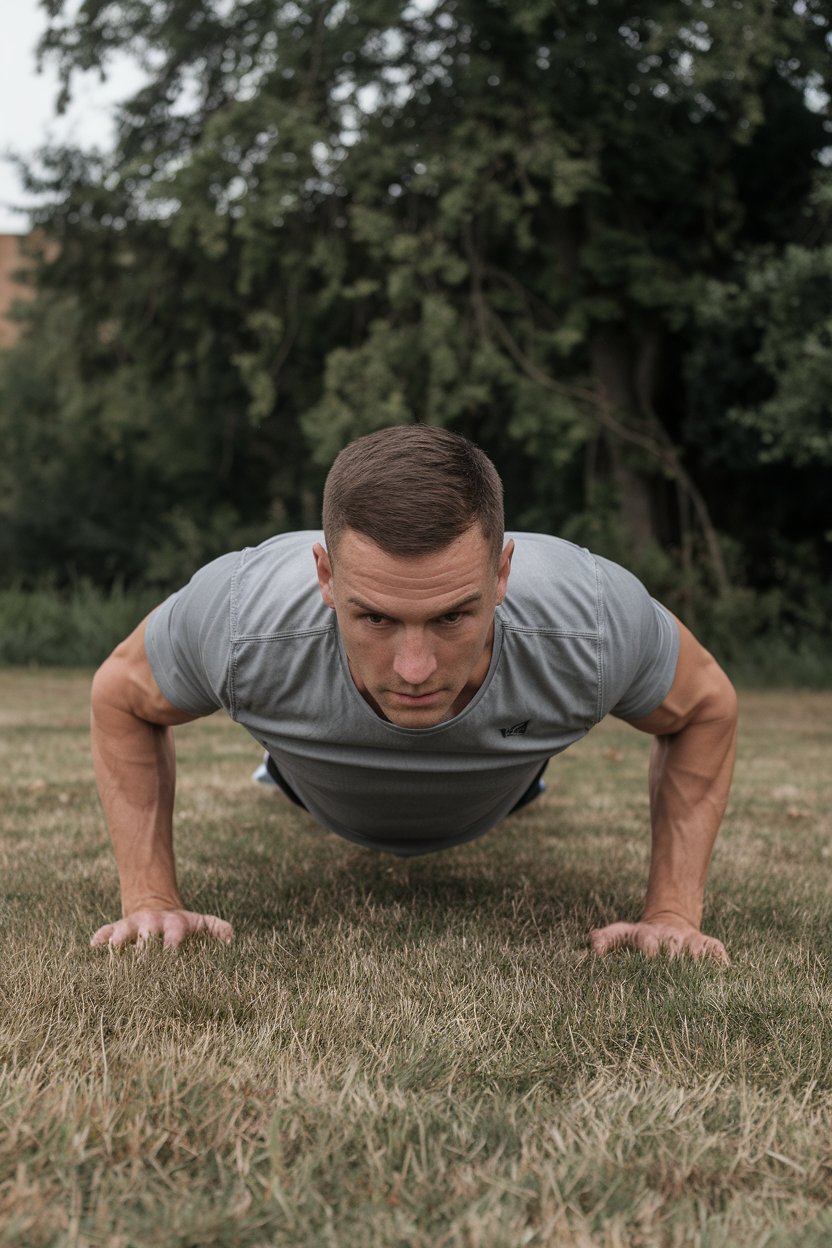5 Bodyweight Exercises For Men That Anyone Can Master
Bodyweight exercises have become an integral part of fitness routines for people of all skill levels, thanks to their accessibility, simplicity, and efficiency. For men, these exercises can offer significant muscle-building and strength-enhancing benefits without the need for a gym or specialized equipment
. Bodyweight training focuses on utilizing the weight of the body to provide resistance, which in turn strengthens muscles, improves endurance, and enhances flexibility.
Whether you’re a fitness enthusiast or a beginner, mastering key bodyweight exercises can greatly improve your overall fitness and conditioning.
Push-ups: A Full-Body Classic for Building Upper Body Strength
Push-ups are often the first bodyweight exercise people think of, and for good reason—they are one of the most effective ways to build upper body strength, particularly in the chest, shoulders, and triceps.
But they don’t just work your upper body; they also engage your core and lower back, making them a comprehensive exercise.
Proper Form and Technique
💥🎁 Christmas & Year-End Deals On Amazon !
Don't miss out on the best discounts and top-rated products available right now!
🛒 Shop Now & Save Big Today!*As an Amazon Associate, I earn from qualifying purchases.
To execute a standard push-up:
- Start in a high plank position, with your hands placed slightly wider than shoulder-width apart, and your body forming a straight line from head to heels.
- Keep your core engaged, ensuring your hips don’t sag or rise above the rest of your body.
- Slowly lower your chest toward the ground by bending your elbows.
- Once your chest is an inch or two from the floor, push back up to the starting position, making sure to fully extend your arms.
Variations for All Levels
For those new to push-ups, knee push-ups or incline push-ups (placing your hands on a raised surface like a bench) are great starting points. These modifications reduce the amount of body weight being lifted, making the movement more manageable.
As you progress, you can increase the difficulty by performing decline push-ups (placing your feet on a raised surface) or plyometric push-ups, where you push off the ground explosively, lifting your hands off the floor between reps.
Benefits
Push-ups help improve upper body strength and endurance while engaging the core for stability. They also enhance functional strength, translating to better performance in everyday activities and sports. By practicing push-ups regularly, men can improve their muscular endurance and build a strong foundation for more advanced exercises.
Squats: Mastering Lower Body Power and Mobility
Squats are a foundational movement that targets the largest muscle groups in the body, including the quadriceps, hamstrings, glutes, and calves. They are essential for building lower body strength and can improve mobility, balance, and coordination.
How to Perform a Perfect Squat
- Stand with your feet slightly wider than hip-width apart and your toes pointed slightly outward.
- Keep your chest up and your back straight as you initiate the movement by bending at the hips and knees, lowering your body as if you’re sitting back into a chair.
- Go as low as you can while maintaining good form, ideally until your thighs are parallel to the ground or lower.
- Push through your heels to return to the starting position, making sure to engage your glutes at the top.
Progressions and Variations
For beginners, bodyweight squats can be performed using a chair for support. As you gain strength and confidence, you can progress to single-leg squats (pistol squats) or add explosive power with jump squats. These variations challenge balance, coordination, and explosive strength, providing a well-rounded workout for the lower body.
Why Squats Matter
💥🎁 Christmas & Year-End Deals On Amazon !
Don't miss out on the best discounts and top-rated products available right now!
🛒 Shop Now & Save Big Today!*As an Amazon Associate, I earn from qualifying purchases.
Squats are one of the most functional movements you can do because they mimic real-life movements like sitting and standing. They also improve overall body strength, making them crucial for any fitness routine. Squats not only enhance muscle mass and strength but also boost metabolism, as they work large muscle groups that require a lot of energy.
Plank: The Ultimate Core Strengthening Move
A strong core is essential for overall fitness, stability, and injury prevention, and the plank is one of the best exercises to build core strength. While it may look simple, maintaining a plank position requires serious strength and endurance from your abs, back, shoulders, and even legs.
How to Perform a Plank Correctly
- Start in a forearm plank position, with your elbows directly under your shoulders and your body forming a straight line from head to heels.
- Keep your core engaged, ensuring your hips don’t drop or rise. Imagine pulling your belly button toward your spine.
- Hold this position for as long as possible while maintaining good form.
Variations and Progressions
If holding a forearm plank is too challenging at first, you can start by performing a plank on your knees or with your hands elevated on a bench. As you progress, there are many ways to make planks more difficult, such as adding leg or arm lifts, or moving into a side plank to target the obliques more effectively.
The Benefits of Planking
Planks build isometric strength in the core, which is vital for stabilizing the spine and maintaining proper posture. A strong core is essential for almost every physical activity, from lifting heavy objects to running and jumping. Additionally, planks can improve balance and coordination, making them an excellent addition to any workout routine.
Pull-ups: Building a Strong, Sculpted Back
Pull-ups are often seen as one of the more challenging bodyweight exercises, but they are also one of the most rewarding. They target the muscles of the upper back, shoulders, and arms, particularly the latissimus dorsi, biceps, and forearms. Mastering pull-ups not only builds upper body strength but also enhances grip strength and overall endurance.
Performing a Proper Pull-up
- Grip the pull-up bar with your hands slightly wider than shoulder-width apart, palms facing away from you (for a traditional pull-up).
- Engage your core and keep your body straight as you pull yourself up until your chin clears the bar.
- Lower yourself back down with control, fully extending your arms at the bottom.
Modifications and Advanced Techniques
For beginners who find pull-ups difficult, using an assisted pull-up machine, resistance bands, or performing negative pull-ups (focusing on the lowering phase) are great ways to build strength. As you progress, you can increase the difficulty by adding weight using a dip belt or incorporating explosive pull-ups into your routine.
Why Pull-ups Are Essential
💥🎁 Christmas & Year-End Deals On Amazon !
Don't miss out on the best discounts and top-rated products available right now!
🛒 Shop Now & Save Big Today!*As an Amazon Associate, I earn from qualifying purchases.
Pull-ups are a comprehensive upper body exercise that targets muscles that are often neglected in other bodyweight exercises. They help build a wide, strong back, improve posture, and enhance overall functional strength. Regularly incorporating pull-ups into your routine will lead to noticeable improvements in your upper body development.
Lunges: A Functional Movement for Lower Body Strength
Lunges are a dynamic movement that targets the quadriceps, hamstrings, and glutes, while also challenging balance and coordination. They are excellent for improving lower body strength, symmetry, and flexibility.
Lunges can be performed in various directions—forward, reverse, or lateral—each offering slightly different benefits.
How to Perform a Basic Lunge
- Stand tall with your feet hip-width apart.
- Take a step forward with one leg, lowering your hips until both knees are bent at 90-degree angles. Make sure your front knee is directly over your ankle, and your back knee is hovering just above the ground.
- Push through the heel of your front foot to return to the starting position.
- Alternate legs and repeat.
Variations for Different Fitness Levels
Beginners can start with stationary lunges, where they remain in one position, and focus on lowering and raising their body. As you advance, you can move to walking lunges, reverse lunges, or even jump lunges for an explosive, plyometric challenge.
The Benefits of Lunges
Lunges not only build lower body strength but also improve balance and coordination. They are a unilateral exercise, meaning they work each leg independently, which helps to address muscle imbalances. Lunges are also functional, mimicking movements we use in everyday activities, and are particularly beneficial for improving athletic performance.

